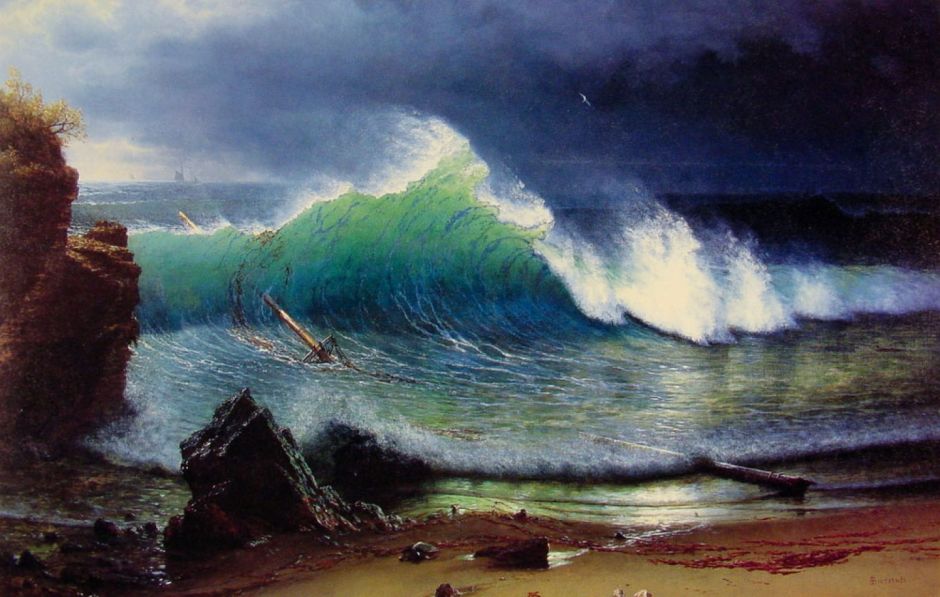In the first of these two articles looking at paintings of near-breaking waves, I showed how unusual they had been before European artists saw Hokusai’s Great Wave in about 1856. After that, Courbet painted a series of them, and during the following decades they became increasingly popular.

The great American landscape artist Albert Bierstadt only painted about thirty coastal views out of a total of around five hundred catalogued paintings, but at least three of them show breaking regular waves. In May 1872, he visited the Farallon Islands, a group of uninhabited rocks thirty miles to the west of San Francisco, responding with his dramatic Seals on the Rocks, Farallon Islands (c 1872-73).

Bierstadt’s wife was diagnosed with ‘consumption’ in 1876, and the following year the couple visited Nassau in the Bahamas, where they hoped the warmer climate would help her condition. During that visit, Bierstadt was inspired to paint The Shore of the Turquoise Sea (1878), showing a wave breaking on the coast there: surely a direct reference to Courbet and Hokusai. Bierstadt also painted a second, larger development from this work after 1878, now exhibited in the Haggin Museum in Stockton, CA, as After a Norther.

Renoir followed in painting The Wave on the Normandy coast in the summer of 1882.

Other French Impressionists and their successors seemed less impressed with Hokusai, preferring different Japonist themes such as tree blossom. The Great Wave found greater enthusiasm with Paul Gauguin and his circle who gathered first in Pont-Aven then Le Pouldu in Brittany. Gauguin’s gouache Seaweed Gatherers I (1888-90) shows two Breton women gathering seaweed on the beach. Behind them is a huge wave, its spume formed into a claw, which surely came from Hokusai.

In 1889, Gauguin painted two works showing Ondine in the sea among waves. The first, known now as In the Waves, or Ondine (I), also refers to Hokusai.

Walter Crane’s Neptune’s Horses from 1892 is one of a series of paintings he made fusing the horses drawing Poseidon’s chariot with near-breaking waves, popularly known in English as white horses.

Henry Moret, one of the Pont-Aven school, found his Waves at Pen-men, Île de Groix, on the far western tip of the island of Groix, with the mountainous sea for which this part of the Bay of Biscay is notorious.

The Nabi sculptor, and painter from Gauguin’s school, Georges Lacombe took Hokusai’s motif forward in several of his paintings. This is his treatment of Vorhor, The Green Wave in egg tempera, which shows an Atlantic swell coming into the seacliffs of Vorhor near Camaret-sur-Mer in Brittany.

Lacombe’s slightly later The Violet Wave also makes its influence abundantly clear.

In that same year, even the notoriously academic artist William-Adolphe Bouguereau joined Hokusai’s crowd of admirers, in The Wave.

My last example of a post-Hokusai near-breaking wave is one of the late marine paintings of William Trost Richards: Off the Coast of Cornwall from 1904. In its impeccably painted breakers are the spirits of Bierstadt, Courbet, and Hokusai himself, who had died in 1849.

